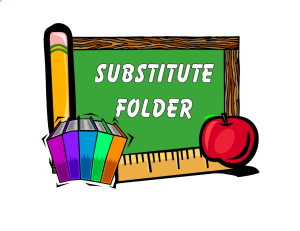[fusion_builder_container hundred_percent=”yes” overflow=”visible”][fusion_builder_row][fusion_builder_column type=”1_1″ background_position=”left top” background_color=”” border_size=”” border_color=”” border_style=”solid” spacing=”yes” background_image=”” background_repeat=”no-repeat” padding=”” margin_top=”0px” margin_bottom=”0px” class=”” id=”” animation_type=”” animation_speed=”0.3″ animation_direction=”left” hide_on_mobile=”no” center_content=”no” min_height=”none”]
It happens. You have to take a day (or more) off from school. Sometimes you can plan ahead, and other times you face unexpected circumstances. In steps a substitute to fulfill your role. The job of a sub is never easy, but you can make it easier by simply preparing ahead. Additionally, you will be helping yourself by decreasing the chances of coming back to a rowdy classroom and a sour note from the sub. Even if you have no plans of using your leave anytime soon, you should always be prepared for a substitute by the beginning of the school year.
The first item on the agenda is to acquire a substitute folder. Some districts offer you free substitute folders, or you might have to buy your own. It can be a plain folder, or you can visit a school supply store and purchase a fancier version that is already sectioned. Just make sure the folder itself is sturdy and clearly labeled. Keep the folder in an easily accessible place and let the school secretary as well as your teacher friends know where this folder can be located. (You never know when an emergency will call you away before you have a chance to neatly place the folder on your desk.)
What follows is a list of items that you should keep in the folder:
1. Your schedule with times and locations of your classes (important if you float). Also, names of co-teachers and teacher assistants and their roles if applicable.
2. Procedures for whatever applies in your classroom: warm-up, dismissal, recess, lunch, hall passes, gathering supplies, etc.
3. Procedures for discipline. Your substitute needs to know what to do in case a student misbehaves. I personally leave a discipline form and encourage the substitute to send the student directly to the office, and I warn my students beforehand. (“The sub will have an office referral form and is not afraid to use it!”) This helps to discourage students from going too far with a sub as well as empowers the stand-in teacher.
4. Roster with attendance slip (or log-in information). A seating chart should be supplied if you use one; this could help the substitute take attendance more quickly. Over-achievers can take pictures of their students and put their names on the photos. (Make sure you have parent/guardian permission to take pictures in your classrooms. You can search for a generic photo permission form online; this should be sent out during the beginning of the year.)
5. Notes about students with special needs or services. Before you do this, check with your principal about your district policies. In my district, substitutes have to sign a privacy policy form before they can sub. To be safe, I still make a bold statement about the confidentiality of the information I am supplying. Sample information I have shared with the sub included the following: a student who required bathroom trips whenever requested, a student who had epilepsy and how to deal with the situation in case the student had a seizure, and a student who had to have a clear line of sight to the speaker’s lips. Again, I leave a note explaining to the substitute that he or she cannot discuss this information with anyone at any time.
6. Notes about students with discipline issues. I have had to teach students who were banned by administration from leaving the classroom during class time, for they had been caught doing something they should not have. A substitute needs to know this, for these students will try take advantage of having a sub. I would even mention to my class that I was leaving certain details with my replacement (without calling on anyone specifically).
7. Names of trustworthy students who can assist with the class, like taking attendance to the office or describing regular classroom procedures.
8. Names of helpful teachers and their locations in case the sub has a question over something you may have missed.
9. Detailed classroom activities and assignments for the day. If you have time to prep beforehand, leave related handouts within easy reach or at least explain where they are. (You might want to tell your trustworthy students, too.) Remember, most substitutes are not licensed teachers, and even if they are, they may not be licensed in your field and/or grade level. Keep the assignments simple and leave the sub an answer key if applicable. For example, I would have students read something independently, answer questions, and write a response to it. Each activity should be timed, as well – let your sub know how much time is reasonable for a warm-up activity, for example. I would also allow them to compare answers with their peers at the end. Finally, I would also have the substitute take up the work (and let the students know beforehand) so that the students took it seriously. (If the majority of the class worked without a hitch, they may get an easy, yet minor, grade for the assignment. If the majority of the class acted up or neglected to complete the work, I would grade the assignment much more harshly. I want the students to take any lessons I leave behind for a substitute seriously.)
10. Emergency lesson plans – these must be made well ahead of time. If you unexpectedly wake up sick or your child lands in the hospital, the last thing you want to worry about is your classroom. Sure, you may have generous co-workers who will supply your sub with activities, but why should you take advantage of that support when you could spare your colleagues the added stress? I recommend at least three days’ worth of activities and again, keep it simple. In my case, I left behind logic puzzles and various fun writing assignments. I also left an educational movie behind, too, just in case.[/fusion_builder_column][/fusion_builder_row][/fusion_builder_container]




